The Green Run, Radiation Experiments, DuPont, and the Pharmaceutical Industry
A Systemic Cycle of Harm and Profit
In December 1949, the U.S. government conducted the Green Run experiment at the Hanford Site in Washington State.
This experiment involved the intentional release of radioactive iodine-131 and xenon-133 gases into the atmosphere, under the guise of studying nuclear fallout. Thousands of unsuspecting civilians living near the Hanford facility were exposed to radioactive materials, with no warning or informed consent.
The release of iodine-131, in particular, targeted the thyroid gland, a critical organ that regulates metabolism and energy use in the body. The result of this exposure seems to be correlated with a sharp rise in miscarriages, cancers, thyroid disorders including hypothyroidism, thyroid cancer, and other long-term health complications, which were directly linked to the radiation.
While the Green Run is often remembered as an isolated experiment, it was part of a broader pattern of deliberate radiation exposure experiments conducted by the U.S. government throughout the mid-20th century These experiments were not limited to Hanford; they extended across the country, and involved several agencies and corporations, most notably DuPont, which had extensive involvement in both the Manhattan Project and in the management of nuclear experiments at Hanford.

For years, the Hanford Atomic Products Operations in Washington secretly released radioactive materials like iodine-131 and xenon-133 into the environment, culminating in the notorious "Green Run" experiment of 1949, which deliberately released large amounts of these substances to study their spread. Yet, routine emissions continued well beyond that event, raising suspicions among locals who believed the radioactive releases were linked to increased cases of illnesses, particularly thyroid disorders. In 1986, the Department of Energy finally admitted to these releases, prompting outrage and congressional scrutiny.
This led to the launch of the Hanford Thyroid Disease Study (HTDS) in 1988, commissioned by Congress, funded by the CDC, and carried out by the Fred Hutchinson Cancer Research Center (all a part of various DoD consortia but nothing to see here). The study primarily focused on iodine-131, which accumulates in the thyroid, but largely overlooked the impact of xenon-133, which can cause respiratory issues.
Years later, when the National Research Council reviewed the HTDS findings, they flagged possible flaws and even potential falsification, raising suspicions of a cover-up to downplay the health crisis. Critics, including scientists, journalists, and local residents, argued that the study underreported the extent of radiation-induced illnesses, leaving the true impact on the surrounding population shrouded in controversy.
These issues continue to pose a lasting threat to public health and the environment. How can conducting such studies be justified as a matter of national security when they cause such significant harm to both people and the planet?
Experiments similar to the Green Run are still conducted today, though often under the guise of atmospheric or defense research. Sites like the Nevada Test Site in the U.S., Russia’s Novaya Zemlya archipelago, and China’s Lop Nur test facility have reportedly carried out controlled radioactive releases. These modern tests continue to raise alarms among experts and environmental groups who warn of the ongoing health risks to surrounding communities, suggesting that the legacy of Hanford's radioactive experimentation is far from over.

Hanford Site's Elite Security Force: Why Is It Still Necessary?
The Hanford Site employs a Special Response Team (SRT) of highly trained patrol officers, adding nine new members in 2023. Managed by Hanford Mission Integration Solutions, this elite team undergoes rigorous training in advanced tactical and counterterrorism skills at the site's training academy.

Candidates must pass a challenging selection process, including physical tests, weapons proficiency, and interviews, and even after being accepted, they must prove themselves through intensive close-quarters combat and de-escalation exercises. Their continued presence suggests ongoing concerns about protecting the site’s sensitive materials and preventing potential threats, possibly linked to its legacy of nuclear waste and the high-security risks associated with hazardous remnants.

DuPont's Role in the Manhattan Project and the Green Run
DuPont, the giant chemical company, was central to the development of the atomic bomb as part of the Manhattan Project.
They oversaw the construction and operation of the B Reactor at the Hanford site, which was responsible for producing plutonium for the bomb.

DuPont was not simply a passive participant in these nuclear experiments—they were actively involved in military contracts and benefited from the growth of the nuclear weapons program. Their participation was essential in maintaining and expanding the U.S.'s nuclear capabilities, which also meant they were responsible for managing the risks of nuclear testing, including fallout exposure to civilians.
DuPont’s role did not end with the Manhattan Project. In 1949, the Green Run was conducted as part of ongoing experiments to study the effects of nuclear fallout. Although DuPont was supposedly not directly responsible for the decision to release radioactive materials, they were deeply entrenched in the Hanford operation and thus complicit in the broader program of radiation experiments conducted during the Cold War. These experiments were often carried out under the auspices of military and civilian agencies with little regard for the safety or well-being of the public.

Other Radiation Experiments: A Pattern of Harm
The Green Run was not an isolated incident; it was part of a larger network of radiation experiments conducted throughout the 1940s and 1950s.

These included a number of deliberate exposures on vulnerable populations:
The Injection of Radioactive Isotopes into Human Subjects (1940s-1950s): One of the most notorious radiation experiments involved the injection of radioactive materials into unwitting patients—often children, minorities, the elderly, and pregnant women—at various hospitals and research institutions. For instance, in the Atomic Energy Commission's (AEC) radiation experiments, pregnant women were injected with radium and other radioactive substances to track the effects of radiation on the fetus.
Children were also injected with radioactive iodine to study its uptake in their thyroid glands. These experiments were done without informed consent and with little regard for the victims’ health. The famous “Radioactive Baby” experiments included the injection of radioactive iodine-131 into infants in order to study its effects on the thyroid. Some infants, born in hospitals, were unknowingly injected with radioactive substances, a practice that continued in secret throughout the 1940s and 1950s.

The Lethal Dose Experiments (1940s): The AEC also conducted experiments in which they deliberately exposed people to lethal doses of radiation to observe the effects of high-level exposure on the human body. These experiments were often performed on patients in hospitals who were unaware of the potential dangers. The goal was to determine how much radiation the body could handle before lethal effects set in, even though many of these individuals were unaware that they were being used as human guinea pigs.
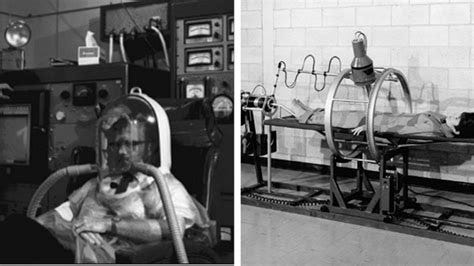

Operation Crossroads (1946): Another significant radiation event was Operation Crossroads, a series of nuclear tests conducted at Bikini Atoll. U.S. military personnel and civilians were exposed to radioactive fallout as a result of the tests. Though supposedly not designed specifically to harm civilians, the fallout from the bomb tests affected numerous nearby populations and was a contributing factor to later health issues.
The Suburban Fallout Experiments: In the late 1940s and early 1950s, radiation experiments were also carried out in urban and suburban areas, often by the AEC and its contractors.
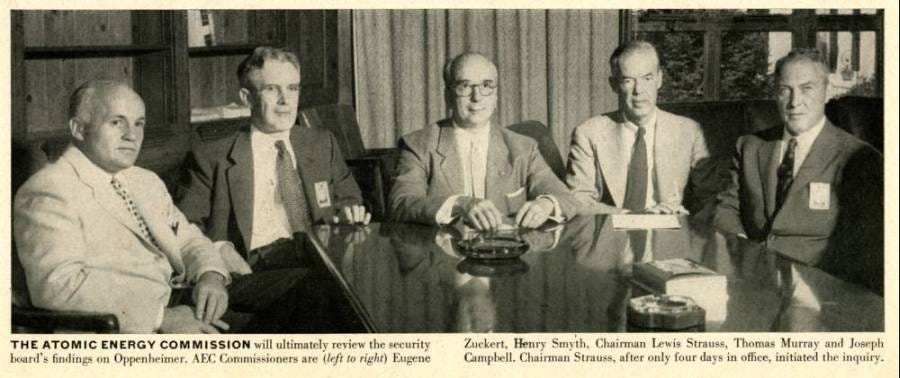
Image from https://scarc.library.oregonstate.edu/coll/pauling/peace/pictures/bio2.036.14-38b-large.html Some of these tests involved releasing radioactive gases into public spaces or distributing radioactive tracer materials through the mail or food supplies, ostensibly to study the spread of radioactive fallout. However, many of these tests resulted in widespread contamination of civilian populations, often without their knowledge or consent.

The Iron Lung Experiment (1940s-1950s): In the aftermath of nuclear tests, the government also conducted experiments involving radiation exposure to individuals, many of whom were subjected to life-threatening amounts of radiation.
Some of these studies involved patients who were kept in iron lungs—a kind of mechanical respirator used for those who had supposedly contracted “polio”—while being exposed to radiation in order to study its long-term effects.
Xenon-133, the Green Run, and the Sinister Side of "National Security":
Xenon-133 (Xe-133) is a radioactive noble gas created during nuclear fission in reactors and weapons tests, typically used in medical imaging to assess lung function. But outside the medical realm, it has a much darker history—especially tied to the infamous Green Run experiment at the Hanford Site in 1949. Under the cover of developing air surveillance techniques to track Soviet nuclear activity, the U.S. government secretly released huge quantities of Xe-133 into the atmosphere, exposing nearby communities to significant radiation levels without their knowledge or consent.
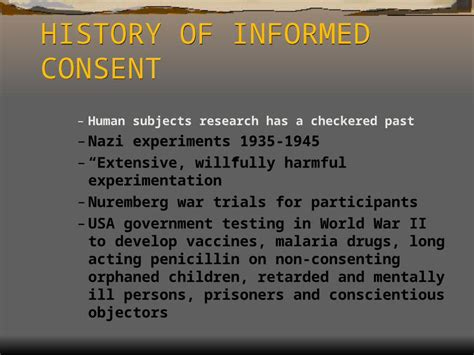
Image from https://dokumen.tips/documents/history-of-informed-consent-human-subjects-research-has-a-checkered-past-nazi-experiments-1935-1945-extensive-willfully-harmful-experimentation-nuremberg.html Inhaled Xe-133 may be chemically inert, but its radioactive emissions can penetrate deep into the lungs, entering the bloodstream and potentially causing cellular damage and mutations that heighten cancer risks, particularly for the thyroid and lungs.

Image from giphy.com While acute exposure can result in nausea, fatigue, and respiratory distress, chronic exposure has far more severe long-term effects. The official narrative claims this release was for national security research, but given the reckless disregard for public health, it raises disturbing questions: What were they really trying to achieve with these horrific “experiments”? The murky motivations suggest it could have been more than just Cold War paranoia—perhaps a deliberate attempt to test human tolerance to radiation, or something even more sinister.
Xenon-133, the Hanford Site, and the Unsettling Legacy of Nuclear Experiments
In the annals of U.S. Cold War history, few projects are as shadowy and controversial as the Green Run experiment conducted at the Hanford Site in 1949. In what was purported to be a study in air surveillance and fallout dispersion, the U.S. government, in co…
These experiments, alongside the Green Run, reveal a troubling pattern of deliberate radiation exposure aimed at studying its effects on the human body, especially on vulnerable groups. While the true extent of these tests remains shrouded in secrecy, the fact that civilians—including children, pregnant women, and the elderly—were routinely exposed to radioactive materials for research purposes paints a chilling picture of a systemic disregard for human life.

The Pharmaceutical Response: Profiting from Created Health Crises
The impact of these experiments did not end with immediate radiation exposure. Many individuals who survived these radioactive tests found themselves suffering from chronic thyroid disorders, including hypothyroidism and thyroid cancer, which were directly linked to the exposure to radioactive iodine-131. These health issues created a new market for pharmaceutical companies that produced thyroid medications.
In fact, during the same period that the government was conducting these radiation experiments, pharmaceutical companies were aggressively developing and marketing synthetic thyroid hormones, most notably levothyroxine, to treat the very conditions caused by radiation exposure.
Pharmaceutical giants like Eli Lilly and others saw a significant increase in demand for thyroid treatments as a result of these radiation experiments. The development of synthetic thyroid hormones in the 1950s, including levothyroxine (which became the standard treatment for hypothyroidism), perfectly aligned with the rise in thyroid disorders among the exposed populations. The pharmaceutical industry, especially in the field of endocrinology, grew significantly as a result of the health issues caused by the government’s radiation tests.

This sequence of events raises troubling questions about whether the government, in collaboration with corporate interests, deliberately orchestrated a crisis in order to foster growth in pharmaceuticals. Green Run experiments and other mid-20th century releases, has long-term consequences for reproductive health, particularly through its impact on thyroid function. The thyroid is key to regulating the body’s reproductive system, and radiation-induced thyroid disorders like hypothyroidism can lead to significant reproductive issues. By exposing large segments of the population to radiation, they helped create a public health problem that was conveniently addressed by newly developed medications—drugs that were ready to be sold to those suffering from the long-term effects of the “government’s” own actions.

The Impact of Radiation Exposure on Reproductive Health
Exposure to radiation, such as radioactive iodine-131 :
Anovulation: Radiation-induced thyroid dysfunction can disrupt ovulation, preventing eggs from being released from the ovaries, making it difficult for women to conceive.
Miscarriage: Women with thyroid disorders, especially hypothyroidism, are at an increased risk of miscarriage, particularly during early pregnancy, due to hormonal imbalances that are crucial for maintaining a pregnancy.
Irregular Menstrual Cycles: Thyroid problems can lead to irregular or absent menstrual cycles, which complicates fertility efforts and can make tracking ovulation difficult.
Reduced Egg Quality: Untreated thyroid dysfunction can result in reduced egg quality, lowering the chances of successful conception and increasing the risk of miscarriage.
Pregnancy Complications: Women with thyroid dysfunction are more likely to face complications like preterm birth, high blood pressure, and preeclampsia, all of which can threaten the health of both mother and child.
For men, thyroid dysfunction from radiation exposure can also impact fertility:
Low Testosterone: Radiation-induced thyroid problems can lead to lower testosterone levels, which are essential for sperm production and overall reproductive health.
Reduced Sperm Count: Thyroid issues can decrease sperm count and motility, significantly hindering a man's ability to conceive.

These thyroid-induced fertility challenges could be contributing factors to the broader fertility crisis today. As thyroid problems and reproductive health issues increase, so does the demand for fertility treatments, creating an ongoing cycle that benefits the fertility industry. Pharmaceutical companies, medical professionals, and the fertility market have profited from these health complications, turning public health disasters into an opportunity for medical intervention and profit.
Thus, the long-term effects of radiation exposure on thyroid health and fertility have likely contributed to a widespread decline in reproductive health, both intergenerationally and in the present day, while the fertility industry continues to profit from the problems they may have helped to create.

The Growing Impact of Thyroid Issues and Cancer
Thyroid-related health issues remain widespread, with approximately 12% of the population expected to experience a thyroid condition in their lifetime. Hypothyroidism, the most common disorder, affects about 1 in 300 people at any given time, especially among women over 60. And once a person is diagnosed they are told they have to remain on medication for life.

The rise in cases can be partly attributed to autoimmune conditions like Hashimoto's disease, but do doctors really understand what is causing this? More than likely not! Alongside these disorders, the incidence of thyroid cancer has increased significantly, with an estimated 43,800 new cases expected in the U.S. in 2024, making it one of the most common cancers, particularly in women. Coincidence?


The Hidden Risks of Radiation Exposure: Are Low Levels Really Low?
Radiation exposure has been a constant part of our environment, from the nuclear tests of the mid-20th century to the widespread use of medical imaging in modern healthcare. These sources of radiation, particularly the Green Run experiment and atomic bomb tests, exposed large segments of the population, including vulnerable groups like children, to potentially harmful doses. As we look at today’s health trends, particularly the rise in thyroid cancers and other radiation-related conditions, a critical question arises: Are the "low levels" of radiation we’re exposed to really as safe as they seem, or are they contributing to a growing health crisis?
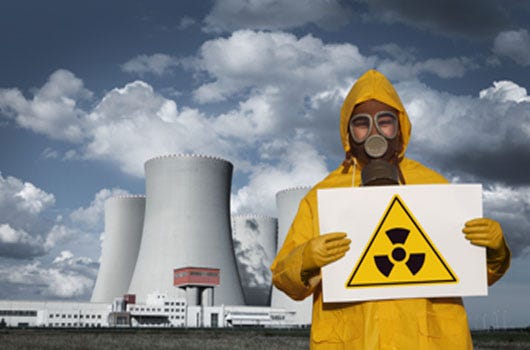
While it's widely known that high doses of radiation can cause severe tissue damage and significantly increase cancer risk, the effects of low-level radiation exposure are more complex. Medical imaging tests such as X-rays, mammograms, CT scans, and PET/CT scans all use radiation, with varying levels of exposure.
Given these figures, it's easy to assume that the radiation exposure from imaging tests is supposedly minimal. However, the cumulative effect of these repeated exposures, especially when considering their long-term impact, may be more dangerous than we realize. Recent studies suggest that low-level radiation from medical imaging can increase cancer risk, including thyroid cancer, particularly in younger individuals. This is a growing concern given the increased use of imaging technologies today, and the possibility that repeated imaging may contribute significantly to the rise in thyroid and other cancers. Are these parameters truly accurate?
Additionally, children are more sensitive to radiation than adults. Their developing tissues and organs are more vulnerable to the harmful effects of radiation, which means that even small amounts of exposure can have more severe long-term consequences.

Healthcare providers are typically cautious when it comes to imaging children, but parents should also be proactive in asking questions about radiation risks and whether there are alternatives to radiation-based imaging.

The connection between past and present radiation exposure cannot be overlooked. The environmental radiation from nuclear testing, combined with today’s medical imaging, creates a perfect storm of risk. The Green Run experiment, along with other nuclear tests, exposed many people to dangerous levels of radioactive iodine, which is linked to thyroid cancer. Fast forward to the present, and the widespread use of imaging technologies may be further compounding these risks, leading to an alarming rise in thyroid cancer rates and other radiation-related health issues. When we add in the fact that radiation exposure from medical imaging is cumulative, it’s clear that what might seem like "low-level" exposure is, in fact, part of a larger, more concerning health issue.

The full scope of imaging radiation exposure deserves closer examination. The combination of past nuclear radiation and modern medical imaging technologies is likely contributing to the increase in cancers, autoimmune diseases, and other health problems we are seeing today.

What we once considered "low-level" radiation may be playing a larger role in our health outcomes than we have acknowledged. It’s crucial that we continue to assess the cumulative impact of radiation, both from past environmental exposure and current medical practices, to better understand and mitigate the health risks we face moving forward.

A Profitable Cycle of Harm and Control
The intersection of the Green Run experiment, the radiation exposure programs, and the rise of the pharmaceutical industry underscores a disturbing reality: a systemic cycle in which harm was created, and then the solution to that harm was sold at a profit. The U.S. government, aided by DuPont and other industrial partners, exposed civilian populations to radioactive substances, resulting in widespread health issues—most notably thyroid disorders. In parallel, the pharmaceutical industry developed medications that became the standard treatments for these radiation-induced health problems, making substantial profits from the very crisis they had helped create.

This creates the very real possibility that the radiation experiments, including those like the Green Run, were not merely accidental or thoughtless experiments, but part of a larger agenda to create a long-term health crisis, one that could be managed—and profited from—by pharmaceutical companies. This cycle of harm and profit was not a coincidence. It speaks to a deeper pattern of control, where government-backed experimentation not only created the conditions for widespread health problems but also fostered the growth of the pharmaceutical industry, which offered the solution to the very problems it helped create.

A Legacy of Exploitation and Control
The Green Run and other radiation experiments conducted during the Cold War era, including those that exposed civilians to radioactive isotopes like iodine-131 and xenon-133, form a disturbing chapter in the history of government-led human experimentation. These experiments were not isolated incidents but part of a broader pattern of radiation exposure, with the U.S. government and corporations like DuPont at the heart of the crisis. The results were catastrophic, leading to widespread health issues that in turn fueled the growth of the pharmaceutical industry—a cycle of harm and profit that continues to reverberate today.
As we look back at these experiments, it’s crucial to understand their lasting effects, not just on the health of the individuals involved, but on the larger systemic relationships between the military, pharmaceutical companies, and the government. The lasting legacy of these experiments remains a stark reminder of the dangers of unchecked power, the exploitation of vulnerable populations, and the ways in which harm can be both created and monetized.












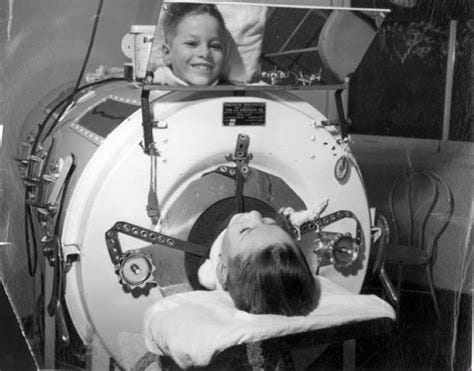







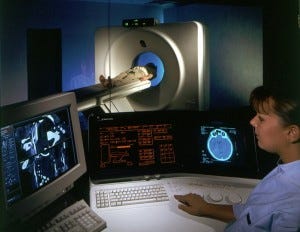
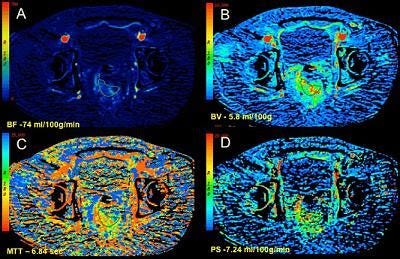



Be careful you aren't getting Rockefellered on this topic...as people were Rockefellered on medicine, diet, and vaccines.
https://atomicinsights.com/rockefeller-foundations-influence-education-health-effect-low-dose-radiation/
https://atomicinsights.com/?s=chernobyl
https://atomicinsights.com/page/2/?s=health
https://atomicinsights.com/galen-winsor-asks-who-owns-the-plutonium-how-much-is-it-worth/
One more brief comment: Some alternative docs recommend thermography for breast cancer screening instead of xrays.
There are other options, like MRIs instead of xrays for other diagnoses. However the contrast medium they use is not safe. Do the sound waves cause problems? I don't know that, but wonder about it. Sonograms, I think they are bad for the developing fetus where they take pictures using sound.